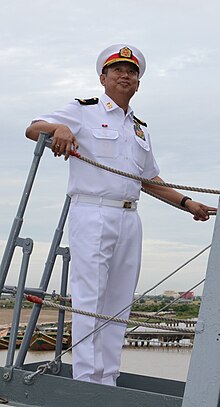Moe Aung | |
|---|---|
မိုးအောင် | |
 Moe Aung visiting a Russian navy ship in 2016 | |
| Commander-in-Chief of Myanmar Navy | |
| In office February 2021 – January 2024 | |
| Leader | Min Aung Hlaing |
| Preceded by | Tin Aung San |
| Succeeded by | Zwe Win Myint |
| National Security Advisor to the State Administration Council | |
| Assumed office 7 January 2024 | |
| Preceded by | Yar Pyae |
| Personal details | |
| Born | 1970 (age 54) Burma (now Myanmar) |
| Spouse | Aye Khine Nyunt |
| Parent |
|
| Alma mater | Defence Services Academy |
| Military service | |
| Allegiance | |
| Branch/service | |
| Years of service | 1988–present |
| Rank | |
Moe Aung (Burmese: မိုးအောင်; pronounced [mò áuɴ]; born 1970) is a Burmese naval admiral who currently serves as the commander-in-chief of the Myanmar Navy.[1][2][3][4] He was appointed to this position following the 2021 Myanmar coup d'etat, succeeding Admiral Tin Aung San, who transitioned to a role of the State Administration Council (SAC), the military junta.[5][6][7][8] As Commander-in-Chief, Moe Aung has overseen significant modernization efforts within the Myanmar Navy.[9][10][11] His leadership has facilitated the acquisition of advanced naval assets, including new submarines, which have been crucial in enhancing Myanmar’s maritime defense capabilities.[12][13][14] His tenure has focused on upgrading the navy's operational and strategic assets to improve its effectiveness.[15][16] Moe Aung has played a key role in expanding the navy’s officer training programs, aimed at developing the skills and expertise of naval personnel.[17][18] He has also been crucial in establishing strategic international partnerships with countries such as India and Russia.[19][20]
In January 2024, Moe Aung was appointed National Security Advisor on the State Administration Council, while his chief of staff, Zwe Win Myint, assumed the role of commander-in-chief of the Myanmar Navy.[21][22][23][24] In his role as National Security Advisor, Moe Aung oversees the formulation and implementation of Myanmar’s national security policies and coordinates defense strategies.[25] His role is pivotal in shaping Myanmar’s security framework and addressing key defense issues. His leadership has been central to the modernization and strategic realignment of Myanmar’s naval and defense sectors, marking a significant period of transformation in the country’s military capabilities.
- ^ "NSA Doval Holds Productive Meeting with Russian Counterpart, Discusses Enhanced Bilateral Collaboration". Devdiscourse. 24 April 2024.
- ^ "Commander-in-Chief of Defence Services of Myanmar visits Eastern Naval Command". Devdiscourse. 26 July 2019.
- ^ "Defence Secretary Giridhar Aramane Visits Myanmar To Discuss Matters Relating To India's Security With Country's Senior Leadership". News on Air. 1 July 2023.
- ^ "Min Aung Hlaing and His Generals: Data on the Military Members of Myanmar's State Administration Council Junta". ISEAS-Yusof Ishak Institute. 23 July 2021.
- ^ UKyaw (4 February 2021). "ဒုတိယ ဗိုလ်ချုပ်ကြီး မောင်မောင်အေး ကြည်း၊ ရေ၊ လေ ညှိနှိုင်းကွပ်ကဲရေးမှူး ဖြစ်လာ". ဧရာဝတီ (in Burmese). Retrieved 19 February 2023.
- ^ "Meeting With The Deputy Minister Of Defense Of Russia, This Is What The Leader Of The Myanmar Military Regime Discussed". VOI.ID. 31 March 2021.
- ^ Htet Myet Min Tun (26 January 2022). "Myanmar's State Administration Council: A Shell Entity". Fulcrum.
- ^ "NSA Ajit Doval meets Myanmar counterpart, discusses India-funded development projects amid continuing civil war". India News Network. 25 April 2024.
- ^ Ei Naing (26 December 2022). "Commander-in-Chief (Navy) Admiral Moe Aung receives Deputy Commander-in-Chief of Russian Navy". Myanmar Transparency News.
- ^ "Commander-in-Chief (Navy) Admiral Moe Aung Receives a Delegation Led by Deputy Commander-in-Chief of Russian Navy Vice Admiral Igor Mukhametshin". infosheet.org. 26 December 2022.
- ^ "Regional Meeting: Myanmar delegation leaves for Russia". Myanmar International TV. 24 April 2024.
- ^ "SAC Chairman Commander-in-Chief of Defence Services Senior General Min Aung Hlaing inspects progress of Myanma Tharkaung War Veterans Housing (Laydauntkan)". Myawady Webportal.
- ^ "C-in-C of Myanmar Armed forces on 3-day visit to ENC". Deccan Herald. 13 July 2017.
- ^ Kyaw Kyaw (11 January 2024). "Commander in Chief (Navy) Admiral Moe Aung was retired and replaced by Chief of Staff (Navy) Vice Admiral Zwai Win Myint. Changes were also made to some of the positions of regional commanders and division commanders". Tha Dinn.
- ^ Agga Aung (31 May 2022). "How Myanmar's Junta Chief Grabbed His 'Other' Inya Lake Home". The Irrawaddy.
- ^ "India supplies weapons parts to Myanmar junta, undermines sanctions". Myanmar Now. 1 March 2023.
- ^ "Commander-in Chief (Navy) Admiral Moe Aung inspects naval bases in Sittway". Ministry of Information (Myanmar). 29 May 2023.
- ^ "Myanmar junta removes navy chief, eastern command head". Narinjara News. 10 January 2024.
- ^ "As Losses Mount, Myanmar's Junta Tightens Its Embrace of Russia". The Irrawaddy. 22 April 2024.
- ^ "Chairman of State Administration Council Commander-in-Chief of Defence Services Senior General Min Aung Hlaing Meets Military Personnel and Families from Sittwe and Kanni Stations". Ministry of Information (Myanmar). 13 July 2023.
- ^ "Myanmar Navy Chief Transferred to National Security Advisor". The Irrawaddy. 9 January 2024.
- ^ "Myanmar Junta Chief Visits Moscow for Security Conference". The Irrawaddy. 21 June 2021.
- ^ "Myanmar, Russia discuss enhancement of friendly relations and cooperation between two navies". Eleven Media Group. 5 November 2023.
- ^ Aung Thit (11 October 2023). "A Corrupt Business Empire Thrives Under the Junta". The Irrawaddy.
- ^ "Senior General Min Aung Hlaing, his wife Daw Kyu Kyu Hla console injured Tatmadaw members, police members". Myanmar Digital News. 11 December 2023.